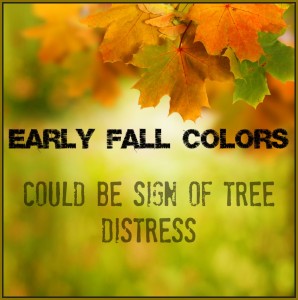In many parts of North America, people will soon enjoy one of nature’s finest shows – fall foliage. Color-changing leaves make for a beautiful display, but early changes in leaf-color can be a sign that your tree is stressed and is susceptible to insect and disease attack.
If the leaves on your trees seem to have gotten a jump-start on fall compared with those on similar trees in the area, you might want to consult a professional arborist who can identify any problems and offer possible solutions.
“Premature colors can be an indication that a tree isn’t vigorous enough to withstand insects and disease organisms that may attack it, not to mention the usual changes that occur when the weather turns cold,” says Tchukki Andersen, staff arborist with the Tree Care Industry Association. “Occasionally, only one or two limbs of the tree will show premature fall color. This could be a sign of a disease at work, weakening only the infected limbs.”
 The more common situation is for the entire tree to exhibit premature fall coloration, a phenomenon usually linked to root-related stress. “Trees respond to these stresses by trying to curtail their above-ground growth,” adds Andersen.
The more common situation is for the entire tree to exhibit premature fall coloration, a phenomenon usually linked to root-related stress. “Trees respond to these stresses by trying to curtail their above-ground growth,” adds Andersen.
Leaves can be thought of as small factories containing raw materials, products and by-products, all in chemical form and some with color. As the leaf is “abandoned” by the tree, the green chlorophyll – the dominant chemical found in most leaves – is broken down and “recycled,” leaving behind other-colored chemicals. Supply lines to the leaves also become clogged. If the major chemical remaining in the abandoned leaf is red, the leaf turns red. If it’s yellow, the leaf turns yellow, and so on.
“The yearly variation in color intensity is due to varying weather conditions, which can affect the balance of chemicals and their composition in the leaves,” Andersen says. Differing amounts of rainfall, sunlight, temperature, humidity and other factors may have an effect on how bright, how quickly, and how long the “leafpeeping” season will be in any given year.
-Thank you to Tree Care Industry Association for this article.
Should you have any questions or concerns regarding your trees and premature discoloration, please contact us! We would be more than happy to evaluate your trees and help you have a healthy inviting landscape!









